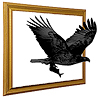| |
|
| |
Advancing the production of a Science Art and nature walk podcast on the Stanford University campus--Currently, the podcast project includes Donald Kennedy and Paul Ehrlich's ten-minute introduction to the
audio tour and two, hour-long,
self-guided loops through portions of the Stanford campus. Donald Kennedy narrates both loops, which feature campus flora and fauna,
sustainability issues, dialogs with various Stanford scholars and works
from the Stanford outdoor art collection that are viewed through a
science lens as examples of Science Art.
Science Art Nature Walk Podcast. |
| |
|
| |
|
|
|
| |
Here's an example of oudoor sculpture from the podcast: Kura |
| |
To view Kura through a cultural lens we might consider the sculpture as the myth well-known to the two Iyatmal artists of the Middle Sepik River region of New Guinea who created the carving. In the narrative, the woman, Kura, was marooned on a lake and saved by a crocodile. She joined the crocodile in his underwater home and bore two children who could morph between eagles and crocodiles, both power symbols. The sculpture shows Kura lifted by one of her bird/crocodile children to carry her back to her village. Viewed from the back, you can see that the bird with the outspread wings has a crocodile’s tail.
To view Kura through a science lens and as an example of Science Art, we might consider the forms through an evolutionary point of view. Take a look at the conjoined bird and crocodile. Birds evolved from dinosaurs, and still carry reptilian traits. In fact, the scale-like skin of the crocodile, like the scales of a snake, for example, appear as feathers once one crosses the evolutionary sequence to birds. |
| |
|
|
 Science Art-Nature
Science Art-Nature Science Art-Nature
Science Art-Nature